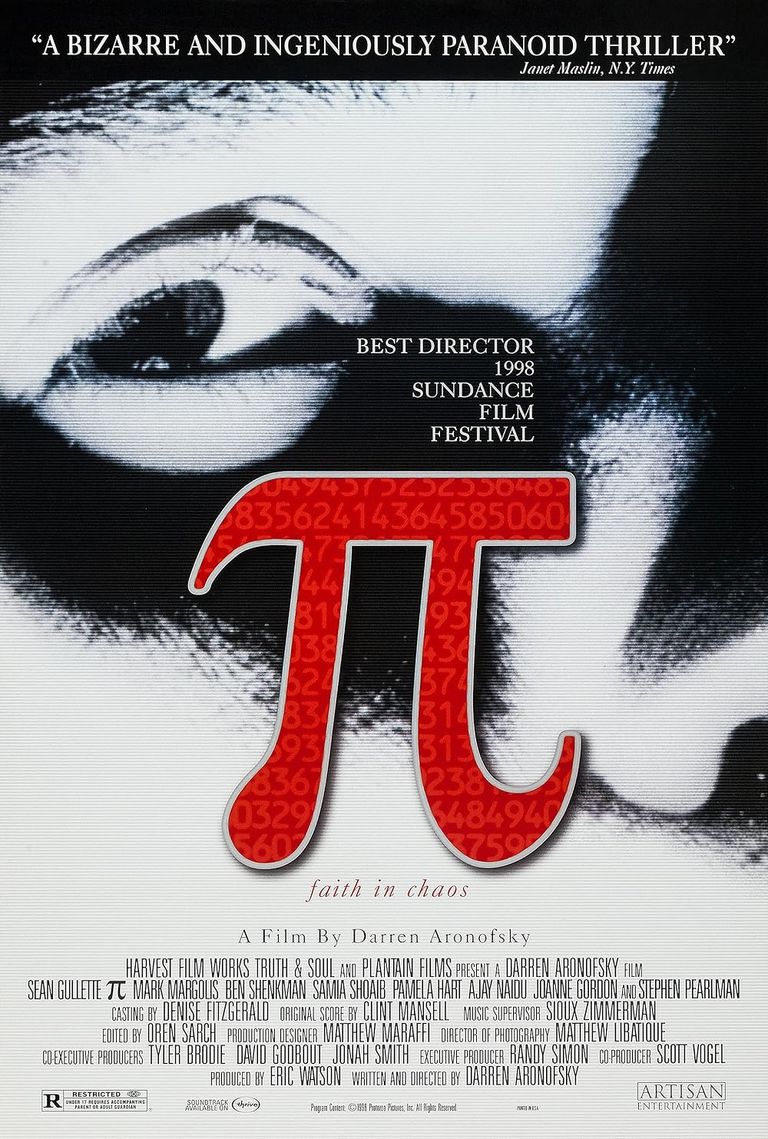
Pi The Order of Chaos is a 1998 film directed by Darren Aronofsky , and starring Sean Gullette .
A low-budget independent film that tackles metaphysical themes from a rational assumption. The film is characterised by the use of shoulder-mounted cameras, high-contrast black and white film and grainy, hyperkinetic editing. The alienating atmosphere is emphasised by the soundtrack which includes Orbital, GusGus, Clint Mansell, Aphex Twin, Massive Attack and Spacetime Continuum. The film won the director's prize at the 1998 Sundance Film Festival and has received numerous international awards.

Pi El Orden del Caos es una película de 1998 dirigida por Darren Aronofsky , y protagonizada por Sean Gullette .
Película independiente de bajo presupuesto que aborda temas metafísicos a partir de un supuesto racional. La película se caracteriza por el uso de cámaras montadas en el hombro, películas en blanco y negro con un contraste muy fuerte y un montaje granulado e hipercinético. La atmósfera alienante se enfatiza con la banda sonora que incluye a Orbital, GusGus, Clint Mansell, Aphex Twin, Massive Attack y Spacetime Continuum . La película ganó el premio al director en el Festival de Cine de Sundance de 1998 y ha recibido numerosos premios internacionales.

Maximillian Cohen, a brilliant but eccentric mathematician, suffered constant migraines caused by staring directly at the sun at the age of 6; he is forced to make intensive use of pills to reduce the pain. A solitary man, he lives almost secluded in his laboratory flat and his only friend is Professor Sol Robeson. Max believes in some principles that govern his life: mathematics is the language of nature; everything that exists can be explained and represented by numbers; in any situation, if analysed in depth, patterns emerge.
Based on these principles, he tries to derive a scheme that allows him to predict share prices. His research brings him to the dangerous attention of some emissaries of a Wall Street-listed company, who expect to speculate on Max's possible discoveries, and who even sponsor and threaten him in order to encourage his research.
In addition, the protagonist comes into contact with an Orthodox Jew, a Torah scholar, who explains to him how each letter of the Hebrew alphabet corresponds to a number: at this point Kabbalistic mysticism and Jewish beliefs merge with what Max (a Jew himself) considers pure and rational. When, finally, Max seems to have succeeded, his computer breaks down beyond repair; not before he has printed out a sequence of 216 digits.
At this point he talks about it with his friend Sol, who explains that he has encountered such a case before when he was investigating pi as a young man; however, his advice is to desist from further investigation, because his sanity is at risk. Shortly afterwards, he is abducted and forcibly brought before Rabbi Cohen (his namesake). The rabbi, initially seemingly benevolent, explains to him that the true name of God is merely a transliteration of the numerical series he discovered.
When Max demonstrates that he does not want to know, the Rabbi shows himself for what he really is, that is, an unscrupulous man, willing to do anything to have that series, since the true name of Yahweh is a priestly secret that was lost after the Roman destruction of the Temple in Jerusalem. Max rebels and embarks on a delirious flight that takes him away from economic interests and orthodox speculation. He also escapes from his own rationality, which has, paradoxically, reached the point of making his own existence irrational.
Later, after having highlighted with a marker a protuberance just above his right ear, he takes a drill and pierces the highlighted spot. At the end of the film Max talks to the girl who used to give him complicated calculations when she met him at the door of her house; he is unable to calculate a multiplication and, perhaps for that very reason, we finally see him smile. The film ends with another question from the little girl, namely the division between 748 and 238, whose result, not revealed by the director, is 3.14 (the fraction is equal to pi with only two decimal places, also because, being irrational, there are no two whole numbers that when divided give π).

Maximillian Cohen, un matemático brillante pero excéntrico, sufría constantes migrañas provocadas por mirar directamente al sol a la edad de 6 años; se ve obligado a hacer un uso intensivo de pastillas para reducir el dolor. Hombre solitario, vive casi recluido en su apartamento-laboratorio y su único amigo es el profesor Sol Robeson. Max cree en algunos principios que rigen su vida: las matemáticas son el lenguaje de la naturaleza; todo lo que existe se puede explicar y representar con números; En cualquier situación, si se analiza a fondo, surgen patrones.
Con base en estos principios, intenta obtener un esquema que le permita predecir los precios de las acciones. Sus investigaciones le llevan a ser objeto de peligrosa atención por parte de algunos emisarios de una empresa que cotiza en Wall Street, que espera especular sobre los posibles descubrimientos de Max, y que llega incluso a patrocinarle y amenazarle para fomentar sus investigaciones.
Además, el protagonista entra en contacto con un judío ortodoxo, estudioso de la Torá, quien le explica cómo cada letra del alfabeto hebreo corresponde a un número: en este punto el misticismo cabalístico y las creencias judías se fusionan con lo que Max (un judío él mismo) considera puro y racional. Cuando, finalmente, Max parece haberlo logrado, su computadora se estropea sin posibilidad de reparación; no sin antes haber impreso una secuencia de 216 dígitos.
En este punto habla de ello con su amigo Sol, quien le explica que ya se encontró con un caso como este cuando investigaba pi cuando era joven; sin embargo su consejo es que desista de seguir investigando, porque su cordura está en riesgo. Poco después, es secuestrado y llevado a la fuerza ante el rabino Cohen (su tocayo). El rabino, inicialmente aparentemente benévolo, le explica que el verdadero nombre de Dios no es más que la transliteración de la serie numérica que descubrió.
Cuando Max demuestra que no quiere saber, el Rabino se muestra como lo que realmente es, es decir, un hombre sin escrúpulos, dispuesto a todo para tener esa serie, ya que el verdadero nombre de Yahweh es un secreto sacerdotal que era perdido tras la destrucción romana del Templo de Jerusalén. Max se rebela y emprende una delirante huida que le aleja de los intereses económicos y de las especulaciones ortodoxas. También escapa de su propia racionalidad, que ha llegado al punto de hacer, paradójicamente, irracional su propia existencia.
Posteriormente, después de haber resaltado con un marcador una protuberancia que tiene justo encima de su oreja derecha, toma un taladro y perfora el punto resaltado. Al final de la película Max habla con la niña que solía proponerle cálculos complicados cuando lo encontraba en la puerta de su casa; es incapaz de calcular una multiplicación y, quizás por eso mismo, finalmente le vemos sonreír. La película termina con otra pregunta de la pequeña, es decir, la división entre 748 y 238, cuyo resultado, no revelado por el director, es 3,14 (la fracción es igual a pi sólo con dos decimales, incluso porque al ser irracional no hay dos números enteros que al dividirlos den π).

Galileo Galilei said: Mathematics is the alphabet with which God has written the Universe.
Pi The Order of Chaos is overall very good. On Rotten Tomatoes the film scored an 86% approval rating, based on a total of 49 reviews. On Metacritic it achieved a score of 72 out of 100 based on 23 reviews. π - The Delusional Theorem has been called the ‘hit American auteur film of the year’.
Sean Gullette, who experienced the making of the film as an intense experience, called the cinematic work ‘a digital Faust story’. Gullette and his friend Darren Aronofsky, the film's director, collaborated on the project for nine months. The actor said: ‘One of the things about the director being a friend is that he knows what buttons to push.
Aronosfky presents the visual traits that would also define Requiem for a Dream (the detailed reaction of an eye to the drug), The Black Swan (Nina's gradual transformation into the sordid dark swan) and The Fountain of Life (2006), in the recreation of a love story in three epochs, with powerful imagery extolled through a spatial bubble.
At the same time, the black and white tonality of Pi makes more evident a ‘square’ world, monotonous and plagued by surrealism with an imaginary of flies and brains worthy of Kafka's references.

Dijo Galileo Galilei: Las matemáticas son el alfabeto con el cual Dios ha escrito el Universo.
Pi El Orden del Caos es en general es muy buena. En Rotten Tomatoes la película obtuvo un índice de aprobación del 86%, basado en un total de 49 reseñas. En Metacritic logró una puntuación de 72 sobre 100 según 23 reseñas. π - The Delusional Theorem ha sido llamada la "película de autor estadounidense de éxito del año".
Sean Gullette, que vivió el rodaje de la película como una experiencia intensa, definió la obra cinematográfica como "una historia de Fausto digital". Gullette y su amigo Darren Aronofsky, director de la película, colaboraron en el desarrollo del proyecto y estuvieron nueve meses. El actor dijo: "Una de las cosas de que el director sea un amigo es que sabe qué botones presionar".
Aronosfky presenta los rasgos visuales que también definirían a Réquiem por un sueño (la detallada reacción de un ojo ante la droga), a El cisne negro (la paulatina transformación de Nina en el sórdido cisne oscuro) y a La fuente de la vida (2006), en la recreación de una historia de amor en tres épocas, con ensalce de poderosas imágenes a través de una burbuja espacial.
A su vez, la tonalidad en blanco y negro de Pi hace más patente un mundo “cuadrado”, monótono y plagado de surrealismo con un imaginario de moscas y cerebros dignos de remisiones de Kafka.
Soundtrack . / Banda sonora .
Clint Mansell is the author of the soundtrack and appears in the film in a cameo as the photography student who is attacked by Max
Clint Mansell (who would become Aronosfky's main musician and appears in the film in a cameo as the photography student attacked by Max), accompanied by the trip-hop of Massive Attack and the electronic mood of the Icelanders GusGus, uses techno to accompany the protagonist's quest, highlighting the enigma of Pi and the digits he is so determined to investigate. Thus, mathematics represents order in life (even in the strategic game Go), but, for Max, it also equals chaos, driving him to the madness of investigating what he loves so much.

Clint Mansell es el autor de la banda sonora y aparece en la película en un cameo como el estudiante de fotografía atacado por Max
Clint Mansell (quien se convertiría en el músico de cabecera de Aronosfky y aparece en la película en un cameo como el estudiante de fotografía atacado por Max), acompañado por el trip-hop de Massive Attack y el mood electrónico de los islandeses GusGus, recurre al techno para acompasar la búsqueda del protagonista, resaltar el enigma de Pi y los dígitos que tanto se empeña en investigar. Así, las matemáticas representan el orden en la vida (incluso en el estratégico juego Go), pero, para Max, equivale también el caos, al orillarlo hacia la locura por investigar lo que tanto ama.

Sean Gullette: Maximillian "Max" Cohen
Mark Margolis: Sol Robeson
Ben Shenkman: Lenny Meyer
Pamela Hart: Marcy Dawson
Stephen Pearlman: Rabbi Cohen
Samia Shoaib: Devi
Ajay Naidu: Farrouhk
Kristyn Mae-Anne Lao: Jenna
Joanne Gordon: Ovadia
Lauren Fox: Jenny Robeson
Clint Mansell: photographer

Sean Gullette: Maximillian «Max» Cohen
Mark Margolis: Sol Robeson
Ben Shenkman: Lenny Meyer
Pamela Hart: Marcy Dawson
Stephen Pearlman: Rabino Cohen
Samia Shoaib: Devi
Ajay Naidu: Farrouhk
Kristyn Mae-Anne Lao: Jenna
Joanne Gordon Ovadia
Lauren Fox: Jenny Robeson
Clint Mansell: fotógrafo


Sources / Fuentes:
Screenshots / Capturas de pantallas : IMDB.
Divider text / Separadores de texto: PNGtree
Final banner of the post / Banner final del post: Pixabay.
Links to my websites / Los enlaces de mis sitios web :
